|
A Virtual Art Collection from various sources provides insights into aspects
of medieval piety.
Facts and Photos
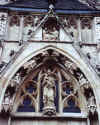 Marian
piety was particularly strong in the Middle Ages. In this period of Christendom,
with no separation between "the sacred" and "the secular,"
religious art, particularly Marian works, adorned all types of buildings. Photo
A is not the entrance to a church dedicated to the Blessed Mother, but is the
entrance to the Rathaus–or town hall–in Aachen, built in the 14th century.
Since the cathedral was dedicated to her, Mary was the patron saint of the city.
Naturally her statue would adorn the entrance to city hall. Marian
piety was particularly strong in the Middle Ages. In this period of Christendom,
with no separation between "the sacred" and "the secular,"
religious art, particularly Marian works, adorned all types of buildings. Photo
A is not the entrance to a church dedicated to the Blessed Mother, but is the
entrance to the Rathaus–or town hall–in Aachen, built in the 14th century.
Since the cathedral was dedicated to her, Mary was the patron saint of the city.
Naturally her statue would adorn the entrance to city hall.
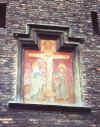 Sharing
honors with his mother on public buildings was Jesus. Photo B shows the
crucified Christ with the women at the foot of the cross. This work is on the
Vogelstor (Bird's Gate), one of the city gates in Augsburg built in the 15th
century. Sharing
honors with his mother on public buildings was Jesus. Photo B shows the
crucified Christ with the women at the foot of the cross. This work is on the
Vogelstor (Bird's Gate), one of the city gates in Augsburg built in the 15th
century.
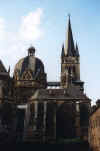 Pilgrimages and relics were important aspects of medieval piety. Aachen was a
major pilgrimage site because of the priceless relics it housed since the time
of Charlemagne (+814). In photo C of the Aachen cathedral one can see the
covered walkway or porch connecting the dome and tower. From this high vantage
point the precious relics of Aachen were shown to the pilgrims gathered on the
plaza below. Its famous relics from the time of Charlemagne were first shown in
1312, and the popularity of Aachen as a place of pilgrimage necessitated the
expansion of the church by 1355. Pilgrimages and relics were important aspects of medieval piety. Aachen was a
major pilgrimage site because of the priceless relics it housed since the time
of Charlemagne (+814). In photo C of the Aachen cathedral one can see the
covered walkway or porch connecting the dome and tower. From this high vantage
point the precious relics of Aachen were shown to the pilgrims gathered on the
plaza below. Its famous relics from the time of Charlemagne were first shown in
1312, and the popularity of Aachen as a place of pilgrimage necessitated the
expansion of the church by 1355.
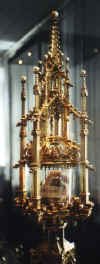 In
799 the Patriarch of Jerusalem presented to Charlemagne four textile relics,
said to be pieces from Jesus' swaddling clothes, from the loincloth worn at his
crucifixion, from the belt of Mary wore at Jesus' birth, and from the
decapitation cloth of John the Baptist. Photo D is the reliquary with the
loincloth of Jesus. The relic itself is encased in crystal in the lower half of
the reliquary. When shown to the crowds, the sunlight would reflect off the
crystal and create a luminous effect. The relic is on display today in the
Treasury of Aachen Cathedral. In
799 the Patriarch of Jerusalem presented to Charlemagne four textile relics,
said to be pieces from Jesus' swaddling clothes, from the loincloth worn at his
crucifixion, from the belt of Mary wore at Jesus' birth, and from the
decapitation cloth of John the Baptist. Photo D is the reliquary with the
loincloth of Jesus. The relic itself is encased in crystal in the lower half of
the reliquary. When shown to the crowds, the sunlight would reflect off the
crystal and create a luminous effect. The relic is on display today in the
Treasury of Aachen Cathedral.
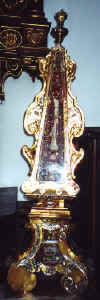 The
most common relics were bones of saints. While early reliquaries (for bones or
other types of relics) were fully enclosed boxes with no view of the contents,
by the Middle Ages they had evolved to show the precious item. Photo E is a tall
reliquary (it stands three to four feet high), displaying a large bone of an
(unknown to me) saint. The reliquary is located in a side chapel in the Saints
Ulrich and Afra Church in Augsburg. While to modern sensibilities reverencing
human bones seems weird and macabre, it can be helpful to remember that
venerating the remains of saints developed early in the life of the church and
was a witness to the central Christian belief in the resurrection of the body. The
most common relics were bones of saints. While early reliquaries (for bones or
other types of relics) were fully enclosed boxes with no view of the contents,
by the Middle Ages they had evolved to show the precious item. Photo E is a tall
reliquary (it stands three to four feet high), displaying a large bone of an
(unknown to me) saint. The reliquary is located in a side chapel in the Saints
Ulrich and Afra Church in Augsburg. While to modern sensibilities reverencing
human bones seems weird and macabre, it can be helpful to remember that
venerating the remains of saints developed early in the life of the church and
was a witness to the central Christian belief in the resurrection of the body.
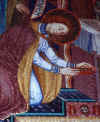 The
honoring of saints, a practice that had obscured the life and work of Jesus
Christ by the time of the Reformation, also originated in the early church,
especially with martyrs. The veneration of a saint started as a local
celebration in the saint's home town or territory. An example of the making of a
local saint in the medieval period is St. Elizabeth of Thuringia. A princess
from Hungary who was married at age 14 to Ludwig IV, Landgrave of Thuringia, she
was attracted to monastic ideas, especially those of the Franciscans. Known for
her care of the sick and poor, she renounced the world completely after the
death of her husband in the Crusade in 1227. Photo F is an early 20th century
mosaic of her in the Wartburg castle, where she had lived. Only 24 when she died
in 1231, the holiness of her life was an inspiration to many and numerous
miracles were attributed to her. She was canonized only 4 years later and her
remains rested in the church bearing her name in Marburg until they were removed
by Philip of Hesse, a leader of the Reformation among political rulers, in 1539. The
honoring of saints, a practice that had obscured the life and work of Jesus
Christ by the time of the Reformation, also originated in the early church,
especially with martyrs. The veneration of a saint started as a local
celebration in the saint's home town or territory. An example of the making of a
local saint in the medieval period is St. Elizabeth of Thuringia. A princess
from Hungary who was married at age 14 to Ludwig IV, Landgrave of Thuringia, she
was attracted to monastic ideas, especially those of the Franciscans. Known for
her care of the sick and poor, she renounced the world completely after the
death of her husband in the Crusade in 1227. Photo F is an early 20th century
mosaic of her in the Wartburg castle, where she had lived. Only 24 when she died
in 1231, the holiness of her life was an inspiration to many and numerous
miracles were attributed to her. She was canonized only 4 years later and her
remains rested in the church bearing her name in Marburg until they were removed
by Philip of Hesse, a leader of the Reformation among political rulers, in 1539.
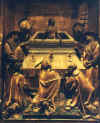 Another
important aspect of medieval piety was the Mass, with a strong emphasis on the
real presence of Christ in the sacrament. This carved altarpiece from ca. 1525
highlights this emphasis (Photo G). The following description is quoted from A
Little Guide to the Treasury of Aachen Cathedral. "The legend of the Mass
of Pope Gregory is depicted, which was very popular in the 15th and 16th
centuries [and] . . . goes back to a medieval legend: during a mass celebrated
by Pope Gregory I [+604], one of the attendants expresses his doubts about the
actual transubstantiation of bread and wine into the body and blood of Christ.
Gregory then asks God for a sign, whereupon Christ appears on the altar as the
Man of Sorrows. As evidence for the Eucharist, blood begins to pour from the
wound in Christ's chest into the chalice on the altar" (29). Another
important aspect of medieval piety was the Mass, with a strong emphasis on the
real presence of Christ in the sacrament. This carved altarpiece from ca. 1525
highlights this emphasis (Photo G). The following description is quoted from A
Little Guide to the Treasury of Aachen Cathedral. "The legend of the Mass
of Pope Gregory is depicted, which was very popular in the 15th and 16th
centuries [and] . . . goes back to a medieval legend: during a mass celebrated
by Pope Gregory I [+604], one of the attendants expresses his doubts about the
actual transubstantiation of bread and wine into the body and blood of Christ.
Gregory then asks God for a sign, whereupon Christ appears on the altar as the
Man of Sorrows. As evidence for the Eucharist, blood begins to pour from the
wound in Christ's chest into the chalice on the altar" (29).
Parallel to the growing emphasis in the Middle Ages on the real presence of
Christ in the eucharistic elements was a declining emphasis on reception of the
sacrament. The laity attended the mass regularly, but generally only received
communion once a year. However, the growing desire by the laity to see the host
led to its elevation by the priest at in the early 13th century during the
singing of the Sanctus in the communion liturgy.
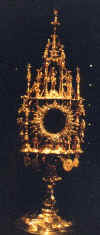 The
monstrance, a vessel for displaying the consecrated host, developed along the
same lines as reliquaries, and made veneration outside of the mass common. Photo
H, a monstrance on display in the Treasury at Aachen, dates from the early 16th
century and may have been a gift to the cathedral by Emperor Charles V on the
occasion of his coronation there in 1519. The dark circle in the center held the
consecrated host. A monstrance could be used to display the host in a side
chapel for veneration, or could be carried in an outdoor procession for
veneration by the crowds, such as on the feast of Corpus Christi. The
monstrance, a vessel for displaying the consecrated host, developed along the
same lines as reliquaries, and made veneration outside of the mass common. Photo
H, a monstrance on display in the Treasury at Aachen, dates from the early 16th
century and may have been a gift to the cathedral by Emperor Charles V on the
occasion of his coronation there in 1519. The dark circle in the center held the
consecrated host. A monstrance could be used to display the host in a side
chapel for veneration, or could be carried in an outdoor procession for
veneration by the crowds, such as on the feast of Corpus Christi.
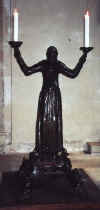 Religious
processions were another important aspect of medieval life. Wolfram of Erfurt, a
single-cast, light-bearing, bronze statue dated ca. 1160 (photo I) was used in
religious processions. Today this masterpiece can be viewed in the Erfurt
cathedral. Religious
processions were another important aspect of medieval life. Wolfram of Erfurt, a
single-cast, light-bearing, bronze statue dated ca. 1160 (photo I) was used in
religious processions. Today this masterpiece can be viewed in the Erfurt
cathedral.
The Reformation brought changes in piety, as two altar pieces demonstrate. In
the pre-Reformation triptych dating from ca. 1515/20 (on display in the Treasury
of Aachen Cathedral), the center panel depicts the only crucifixion–and does
so in such a way to emphasize judgment. The "good" are gathered on the
left side (Christ's right side) with the penitent thief, whose soul is being
received in heaven by angels. On the right side of the panel (which is Christ's
left hand, as in Matthew 25) are the "wicked," along with the
impenitent thief who soul is carried away by demons.
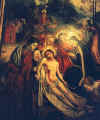 The
panel on the left side depicts three scenes (photo J); in the foreground and
most prominent by size is the descent from the cross, in the middle on the far
left is the entombing of Christ, and slightly above and to the right, on a
smaller scale from the foreground figure, is the resurrected Christ appearing to
Mary. (To enlarge picture, click on it once.) The
panel on the left side depicts three scenes (photo J); in the foreground and
most prominent by size is the descent from the cross, in the middle on the far
left is the entombing of Christ, and slightly above and to the right, on a
smaller scale from the foreground figure, is the resurrected Christ appearing to
Mary. (To enlarge picture, click on it once.)
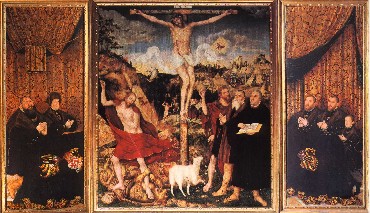
In contrast is the triptych by Reformation artist Lucas Cranach, completed by
his son in 1555 and on display at Saints Peter and Paul Church in Weimar (photo
K, above). First of all the center panel includes both the crucified and risen
Christ on the same scale. Secondly, the whole panel emphasizes not judgment, as
the first one does, but redemption. The blood from the crucified Christ spurts
to the background, where the children of Israel are being saved from the fiery
serpents by looking at the bronze serpent lifted up on Moses' staff. Christ's
redemptive work reaches back in time to all who had faith in God's promise of
salvation. The risen Christ subdues death under one foot and Satan under the
other. On the right stands Martin Luther, pointing to the open Bible in his hand–to
the Word which proclaims this crucified and risen Christ and calls all to faith
in him. | 